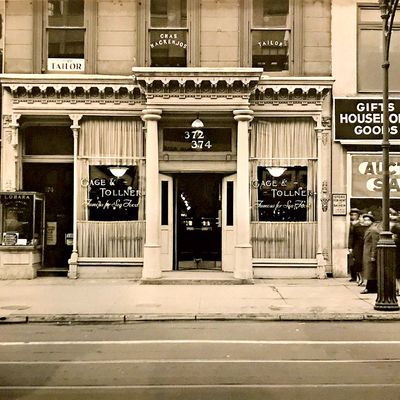
Moving into an old, cherished restaurant space is a tricky thing. You don’t want to alienate the culinary historians and faithful regulars, but you can’t risk becoming a nostalgia act. Here’s a look at five iconic restaurants of the recent and distant past and how the chefs and restaurateurs who are taking them over this fall plan to pay homage.
Le Veau d’Or ➽ Le Veau d’Or
Then: Le Veau d’Or
For over 80 years, the Frenchiest French bistro of them all served classics like frogs’ legs provençale, poussin rôti en cocotte, pommes Anna, and tripes à la mode de Caen with uncommon style and grace.
Now: Le Veau d’Or, 129 E. 60th St.; opens November
If anyone can be trusted not to mess up a universally adored French bistro, it’s new owners Lee Hanson and Riad Nasr of Frenchette, who as a sign of good faith are keeping the name (and the tripe). The question of tablecloths remains up for debate.
Gage & Tollner ➽ Gage & Tollner
Then: Gage & Tollner
Before Peter Luger, before Junior’s — before Di Fara even — there was Gage & Tollner, the Gilded Age chophouse that opened in 1879 and closed 125 years later. In between, it became Brooklyn’s first destination restaurant and New York’s third landmarked interior; after it closed, it ignominiously morphed into a TGI Fridays, an Arby’s, and a succession of discount clothing and jewelry shops. Thanks to false walls and that landmark status, however, its unique, ornate interior remained intact.
Now: Gage & Tollner, 372 Fulton St., Downtown Brooklyn; opens December
Three Brooklyn restaurateurs were looking to open a modest bar when they stumbled into the lease for this place, and they’ve spent the better part of a year doing the heroic work required to resuscitate a dormant institution. St. John Frizell will open the Sunken Harbor Club, a bar designed to evoke an explorer’s club on the second floor. And chef Sohui Kim is studying antique menus like a Talmudic scholar, drawing inspiration from seasonal American classics like Nesselrode pie and Edna Lewis’s she-crab soup.
Red Cat ➽ Mermaid Inn
Then: Red Cat
Jimmy Bradley and his then-partner Danny Abrams opened Red Cat in Chelsea in 1999, post–gallery infiltration but pre–High Line, and until Bradley closed it last year, the place fairly defined the idea of the New York neighborhood restaurant as unpretentious but sort of sophisticated, with the unlikeliest signature dish ever — tempura-fried green beans — summing it all up.
Now: Mermaid Inn, 227 Tenth Ave.; opens October
Bradley and Abrams went on to open Mermaid Inn in 2003, then split amicably in 2007: Bradley got Red Cat, Abrams took Mermaid. So with a new Mermaid branch going into the old Red Cat space, this is a homecoming of sorts for Abrams. Also: Red Cat’s opening chef de cuisine, Michael Cressotti, is back running this kitchen. In short, the place couldn’t be in better hands. Who knows? Maybe they’ll even put Red Cat’s green beans on the menu.
Brasserie Les Halles ➽ Francis & Staub
Then: Brasserie Les Halles
The house that Anthony Bourdain built; he started cooking there in 1998 and remained the official “chef at large” long after they stopped sending him checks. The place went belly-up in 2017.
Now: Francis & Staub, 411 Park Ave. S.; opens October.
New owner, cookware designer Francis Staub, is keeping the look classic brasserie (red leather banquettes, brass finishes) but will presumably rid the kitchen of any leftover Le Creuset. Expect lots of stuff from chef Richard Farnabe’s kitchen that Bourdain would have been down with, including escargot, steak-frites, and whole Dover sole.
Bleecker Luncheonette ➽ 232 Bleecker
Then: Bleecker Luncheonette
For years, this corner-spot soup counter exuded old-school charm and was of a piece with the many family-run Italian-American food shops that once defined the South Village area around Our Lady of Pompeii Church. Its signature dish was a humble soup listed as Green Minestrone on the menu, and served with whole-wheat bread from nearby Zito & Sons Bakery. It was one of those dishes that remains stamped on your brain even if you only had it once, its pleasure derived in part from the old-world allure of the soulful spot itself, sure, but stripped of nostalgia, this soup was still undeniably and kind of mysteriously delicious. Among its fervent followers it was as iconic as any potage in the history of New York food. When the luncheonette closed in the 1990s, the restaurant was taken over by former staffers who renovated the space, expanded the menu, and changed the name to Trattoria Spaghetto.
Now: 232 Bleecker, 232 Bleecker St.; opens October.
The first full-service restaurant from the Dig Food Group (the company behind the healthy quick-serve “farm-fast” Dig chain) is a showcase for former Untitled chef Suzanne Cupps’s veggie-forward cooking. The space has been rejiggered to focus attention on a ten-seat chef’s counter opposite the wood-burning hearth, which you might hopefully interpret as a 21st-century nod to the old soup counter. What would really be fun is if Cupps were to put a nice bowl of green minestrone on her menu.
*A version of this article appears in the September 2, 2019, issue of New York Magazine. Subscribe Now!
More From Fall Preview
- 29 New Restaurants You Need to Know About This Fall
- At Lekka, Dirt Candy’s Amanda Cohen Tackles the Veggie Burger
- Caffè Panna Marries Rome’s Gelato Culture With America’s Mix-in Mania




